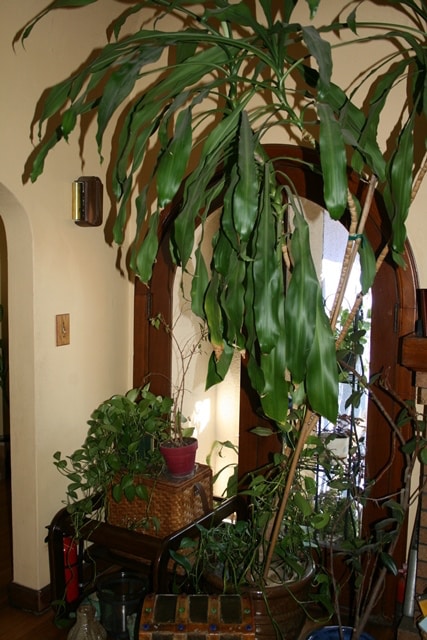Years ago when I purchased my home, I had very little furniture, because I’d sunk all of my savings into the purchase. Craving greenery in what was then a pretty empty living and dining room and wanting to fill up the space, I bought some dracaenas and a schefflera. At the time, they were about 3 feet tall, but they filled in those empty corners nicely.
In time, those plants grew into their spaces—with a couple of the dracaenas now towering at 12 feet tall. As I added to my houseplant family, I found that while smaller plants are accessories that decorate your indoor garden, it’s the large trees that add depth, height and sheer presence to your interior. Tall houseplants anchor corners as they green up indoor spaces and make them homey. Their considerable size also makes them powerful filters for your indoor air.
Though large and tall plants may seem challenging to keep indoors, it’s easier than you might think to grow trees as houseplants if you follow these tips.
Carefully choose your indoor trees. Since large and tall plants take years to grow, they are often a little pricy. It’s not uncommon to pay $50 to $70 or more for a healthy tree. For this reason, it’s important that you use care when choosing an indoor tree. Check that the plant exhibits signs of health, including new growth that seems robust and healthy, firm anchoring in the soil and mature foliage that is vibrant and free of pests.
Protect trees during transport. Avoid moving trees in the open air, as they can experience wind, sun and cold damage. Throwing an indoor tree onto a pickup truck and driving home is akin to putting your tree out in a hurricane. Instead, move them to your house in a covered vehicle. Tape crumpled newspaper to the soil to keep it from spilling out and tie limbs with green garden tape to prevent them from breaking. Always lift the trees from the pot, not the trunk, as doing the latter can cause roots to break.
Place trees in proper lighting. This is so important. All plants get their energy from the process of photosynthesis, which must be done in the presence of light. If you place a tree, or any houseplant, in incorrect lighting, it simply won’t thrive. The plant will do okay for a time, because it will use stored light reserves to live. Once those reserves are depleted, the plant will drop foliage and eventually become spindly and unattractive.
The good news is that there are many excellent trees for medium to low light indoors. These include all of the dracaenas, such as corn plant (D. fragrans ‘Massangeana’), ‘Janet Craig’ (D. cragii compacta) and Dracaena marginata ‘Tricolor.’ Other good choices include Ficus benjamina, schefflera, fiddleleaf fig (Ficus lyrata), various palms and the rubber tree (Ficus elastica).
Water properly. Most indoor trees require a good soaking once the top 3 to 5 inches of soil has dried out. To determine if the plant is ready for watering, insert a moisture meter or use a wooden skewer. Insert the skewer several inches into the soil and remove. If there is wet soil clinging to the skewer, the plant doesn’t require watering, but if the soil is dry and falls off of the skewer, it is time to water.
Because you will most likely be watering tall indoor plants in place, it’s important that they are set on top of a waterproof dish that is filled with river rock. That way the excess water will pool below the rock. This will prevent the bottom of the pot from sitting in wet soil, as this can lead to root rot. If the dish becomes too full of water, remove it with a turkey baster.
Fertilize periodically. How often you feed tall plants will depend on your desires regarding size. If you would like the plant to grow quickly, feed on a monthly basis with a balanced organic fertilizer. If the plant is a good height for its space, feed every three to four months. And if the plant is beginning to outgrow its space, feed just twice a year.
Repotting. Repot tall plants as they outgrow their containers. This occurs when water rushes through the pot quickly and the soil becomes crowded with roots. If you wish to keep the plant in the same container and at its current size, prune roots by one-third and repot in the same container with fresh potting soil.
Julie Bawden-Davis is a garden writer and master gardener, who since 1985 has written for publications such as Organic Gardening, Wildflower, Better Homes and Gardens and The Los Angeles Times. She is the author of seven books, including Reader’s Digest Flower Gardening, Fairy Gardening, The Strawberry Story, and Indoor Gardening the Organic Way, and is the founder of HealthyHouseplants.com.

